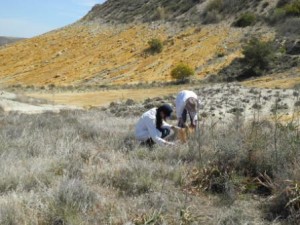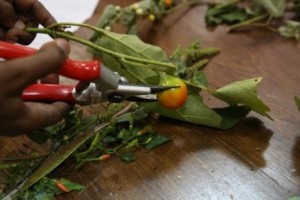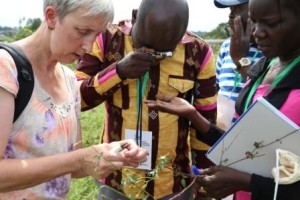Category : News
Published : July 1, 2015 - 7:57 AM
If you were to assess a population of plants for seed collection, how would you go about doing it? Assessing, identifying and collecting seeds correctly is fundamental for long-term seed banking at the MSB. Seed collections that arrive at the MSB should contain the appropriate quantity and high initial viability to effectively conserve them for the long-term. Population assessment also reduces damage to the population that are in habitat.
How to identify a target species?
When a seed collector starts their mission on a seed collecting trip the first aim is to correctly identify the targeted species, which is fundamentally important to the value of seed collections. One of the best ways this can be achieved accurately is through using the seed collecting guides produced for the project by the seed guide compilers at Kews Herbarium. The seed collecting guides contain essential information for identifying target species from the same genus including collection priority, location, habitat, distribution, colour photographs (flowering parts, leaves, stems fruit and seed), descriptions, conservation status, seed collecting techniques and flowering/fruiting months.
How to carry out a seed assessment?
Once the target species has been identified the population should then be assessed. Seed collectors will need to establish how many individual plants there are within the population, what the extent of that population is and at what stage of reproduction the plant is at. Observing whether a population is damaged is crucial for meeting the minimum quality and quantity standards for seed sampling. To gain the most representatively balanced sample of seeds collecting should be conducted in an even and random method from at least 50 plants.
Assessing the readiness, quality and availability of seeds
Establishing when seeds are ready for collection can be done through the following observations; changes in fruit colour and seed coat colour, the splitting/breaking open of fruit, the rattling of seeds in their cases, hard and dry seeds and observing the ground around the area for seeds that may have already been dispersed.
Assessing the physical quality of seeds is a necessary step in seed collecting trips, low levels of non-viable seeds which have been damaged by insects can be identified and collection can be avoided. The cut test technique should be performed in order to effectively and reliably assess seed quality. Selecting 10-20 seeds of the population sample and recording the amount of full, empty, infested and immature seeds will guide selectors into either seeking another population of 20% of the selected seeds are infested and empty or increasing the amount of seeds collected so that any non-viable are compensated for.
Seed availability assessments are achieved by estimating the total number of plants that are at the stage of seed dispersal. According to standards, collections aimed for long-term conservation should contain a minimum of 10,000 seeds that are potentially viable. 10,000 enables full use of the collection including safeguarding in case of wild population loss, testing and developing effective germination protocol, viability monitoring, duplication, distribution and future propagation and restoration. The minimum quality and quantity standards are vital as they keep the population within the safe limit of mature seed collecting at 20%. Going above this 20% risks depleting seeds that would otherwise be available for natural regeneration. Rare and threatened seeds should have a minimum of 500 seeds within their collection as well as having the 20% rule accounted for.
Making the decision: to collect or not?
What happens if the targeted species and population fails to meet the criteria needed? All is not at a lost and several options include locating a different population of the same species, return to the population another time having recorded the co-ordinates with GPS, produce herbarium of the species and finally assess any available species on the target list.
Written by: Danielle Haddad
Kew contributors: Michael Way and Kate Gold
For more information



